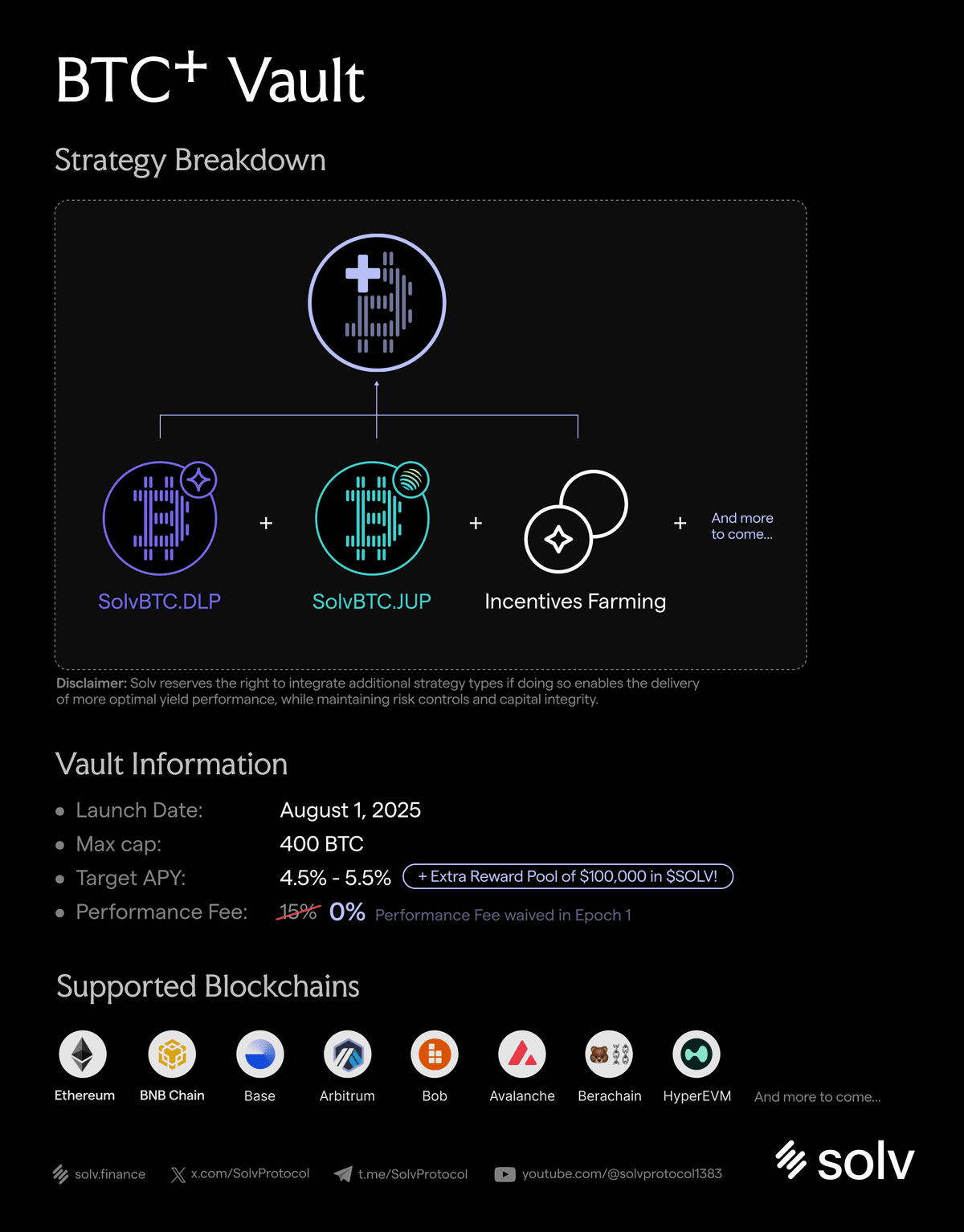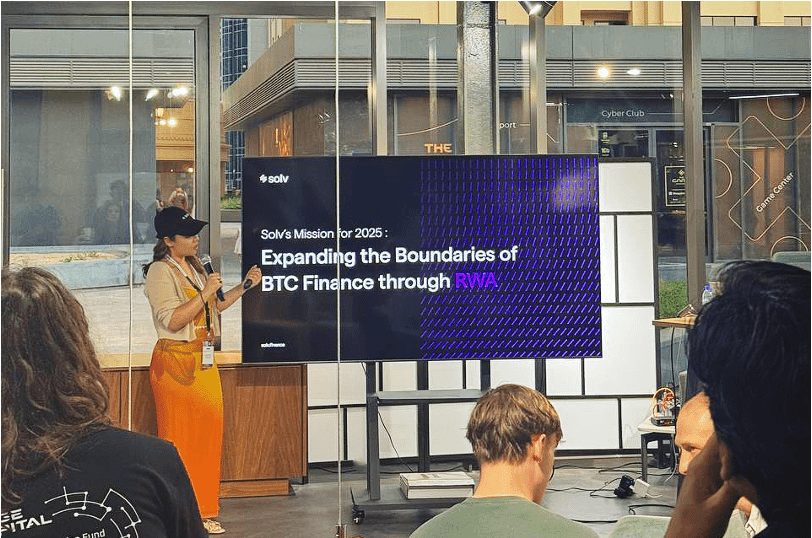Recently, I’ve seen a lot about how to lose money; to be honest, you could just play spot in the crypto space, accumulate BTC, and moreover use BTC.
First, let’s throw out a conclusion: Solv is doing one thing—upgrading Bitcoin from "static position" to "programmable yield asset". You don’t have to watch the market every day, you can let BTC run compliant/risk-controlled yield strategies, and you can withdraw the yield and liquidity at any time to use in DeFi. The official slogan is This is Bitcoin, Unbound!, which means, straightforwardly, "untying BTC’s hands and feet to make it move".
To make it easier to read, I’ll break it down into sections: positioning → product matrix → where the yield comes from → how to manage risks → how funds come in and out → how it differs from peers → who it’s suitable for → common misunderstandings and reminders.
1. Solv’s positioning: "Bitcoin yield layer + cross-chain liquidity base"
Who is it aimed at? It targets users who have BTC and do not want their coins to be "locked up"; also aimed at DeFi applications and institutions that need BTC liquidity.
What pain points does it solve?
1) The native layer of BTC does not run contracts, and to earn yields you have to "bridge back and forth", which is troublesome and carries extra risks;
2) Many "high-yield" strategies are either opaque or rely on verbal risk control.

Solv attempts to streamline these two aspects using standardized certificates + composite yield positions + on-chain verifiability.
Where are we now? Media and data sources report its TVL exceeds $2 billion; recently launched BTC+ (structured yield treasury), aiming to bring "sleeping BTC" into a basket of cross DeFi/CeFi/RWA strategies.
In one sentence: Solv separates "the ownership of BTC" from "the usage of BTC"; what you receive is a liquid BTC certificate (to be discussed later), usable across different chains, while the backend turns the yield into a "configurable strategy position".
2. Product matrix (in plain language 😂)
1) SolvBTC & LST family: cross-chain usable BTC "pass"
SolvBTC is Solv’s "universal BTC certificate", aimed at cross-chain usage (you deposit BTC, mint SolvBTC; to exit, redeem it back). It has a corresponding LST (liquid staking) version, making it easy to generate yields/collateral in other protocols.
The value of this step is: you don’t have to bridge around and fuss repeatedly; the certificates you receive can walk directly across multiple ecosystems and can also stack additional yields.

2) BTC+ (structured yield treasury): Put BTC into a "composite strategy" to earn stable annualized returns.
BTC+ is the flagship product launched in 2025: funding is proportionally allocated to strategies from multiple sources such as DeFi/CeFi/traditional markets (RWA), aiming to provide BTC with base yields in the range of 4.5%–6% (the reference range given by official channels and media, actual is based on on-chain net value).
Highlights: Introduced Chainlink Proof-of-Reserve (PoR) for on-chain reserve proof, as well as NAV withdrawal threshold/risk control mechanism (net value trigger protection), trying to turn "invisible" black boxes into "visible" verifiable data.
RWA exposure: Multiple reports mention strategies will engage with tokenized asset sources like BlackRock’s BUIDL, Hamilton Lane’s SCOPE (note, such "connections/exposures" are descriptions of yield sources and do not equate to "direct cooperative issuance"—information is based on official releases and audit disclosures).
3) Ecosystem expansion: moving yield positions to more active chains
This year, there have been moves to deploy BTC yield products to Avalanche, aiming to leverage its RWA ecosystem and low-cost settlement to make the "BTC yield position" smoother and easier to use.
SolvBTC solves "can it be used", BTC+ solves "how to earn steadily", PoR/NAV solves "dare to use".
3. Where does the yield come from? (Don’t be blinded by "annualized return")
Solv breaks down BTC’s yield sources into several categories, dynamically adjusting according to market conditions, with the core idea being "diversified sources + risk control priority".
1) DeFi side:
Participate in mainstream lending/LP/collateral mining;
Implement basis/term strategies (perpetual and spot, cross-platform interest rate spreads, etc.), aiming for "market neutrality + low volatility".
2) CeFi side:
Funding fee differentials, periodic/instant yield products, market-making yield sharing, etc. (depending on partners and qualified custodians).
3) RWA side:
Configure tokenized government bonds/money market funds, which belong to "coupon-type" base sources with lower volatility;
Multiple reports mention asset pools like BUIDL/SCOPE.

Key point: The essence of BTC+ is not "magical high yield", but "packaging multiple low to medium risk sources into a verifiable net asset value curve". You see the result of a "composite position"; when the market is tight, the position will be more conservative; when the market is good, the position will be more aggressive.
4. How to manage risks? (Others love to tell stories, Solv loves to present "evidence")
1) Proof-of-Reserve (PoR)
Integrated with Chainlink’s PoR, there’s a public reserve proof Feed, allowing users to trace on-chain "exactly how much is backed and where". This is much more credible than "a paragraph on the website".
2) Auditing and security
Contracts audited multiple times, reports from Salus, Quantstamp, etc. can be found; some repositories are also open source (V3, SolvBTC, Vault Guardian, etc.). Auditing is not a talisman, but transparency adds points.
3) Net asset value risk control/NAV withdrawal threshold
BTC+ brings the idea of NAV withdrawal/stopping loss from traditional asset management on-chain: when the net value hits certain thresholds, it automatically reduces positions or switches to more conservative configurations, aiming to narrow "tail risks".
4) Layered architecture & custody isolation
Media reports mention a "dual-layer structure"—separating custody and strategy execution to reduce "single point risk" of managing both funds and investments.
Friendly reminder: No yield product is "risk-free"; please open and look at links for PoR/audits/NAV/custodians, don’t just look at annualized numbers. The advantage of Solv is that there’s an increasing amount of visible data and reports, which is rare in the BTC yield space.
5. How to enter, exit, and use funds?
Enter:
Deposit native BTC at designated entry, the system maps/mints SolvBTC or corresponding LST;
If you want to take the "worry-free route", just go straight to BTC+.
On the way:
You can take SolvBTC/LST to various chain DeFi for collateral, trading, and LP;
Or hold statically, watching the net asset value curve of BTC+.
Exit:
When redeeming, return SolvBTC to the corresponding entry, and the corresponding native BTC will be released according to the rules;
If you take SolvBTC for collateral/loans midway, pay off the debt before redeeming.
Tips: Different chains/entry fees, batch settlement times will vary; check official documents and PoR panels before formal operations, don’t assume. (PoR Feed and official entry can be checked.)
6. Differences from peers (one-sentence review)
Compared to "single platform BTC fixed deposit": Solv is doing a composite strategy + on-chain verifiability; it’s not just giving money to someone for yields, but dispersing sources to achieve "explainable and traceable" results.
Compared to "pure DeFi yield strategies": it includes CeFi/RWA in the mix, making the yield structure more three-dimensional; and it uses PoR/NAV to move the "traditional asset management governance manual" on-chain.
Compared to "BTC L2 / Restaking public chains": Solv’s focus is not on "building a new chain for ecology", but on first perfecting BTC’s yield layer and then expanding usage scenarios across multiple chains (like the deployment on Avalanche).
7. Who is it suitable for? How to use it most conveniently?
Newbie players ("I just want to be steady")
Choose BTC+ for base asset allocation, aiming for basic range annualized returns; don’t chase hot spots.
Regularly check the net asset value curve + PoR panel; in case of significant market fluctuations, do not leverage first.
Heavy DeFi users ("I want liquidity")
Use SolvBTC / LST as collateral, stacking lending/LP yield;
Remember the risk "stacking effect"—the more layers, the more you need to keep an eye on risk control thresholds; don’t put principal at risk for a mere 2% more annualized return.
Institutions/family offices ("I want compliance and verifiability")
Focus on custody isolation, audit reports, PoR links, and clarify risk control parameters during integration (withdrawal thresholds, mismatch limits, maximum drawdown lines, etc.).
If you need RWA exposure, confirm the specific list of targets/liquidation paths, don’t just look at the outer layer "having contact with BUIDL/SCOPE".
8. Common misunderstandings & straightforward answers 🤔
Q1: Does having Chainlink PoR mean "absolute safety"?
A: No. PoR provides "reserves that can be verified", which does not equal "strategy is risk-free". It helps you avoid "mouth-proven reserves", but market risk/counterparty risk still needs to be managed through strategy and risk control.
Q2: Reports say "using BUIDL/SCOPE yields", is it "direct cooperation"?
A: Pay attention to wording. Multiple documents describe "yield sources/exposures", which is not equivalent to "direct collaboration on issuance". The correct approach is to look at product descriptions & audit/NAV reports, based on actual holdings/pathways.
Q3: Is an annualized return of 4.5%–6% guaranteed?
A: It’s not guaranteed returns. This is the "target range/reference range" given by media and official materials; see the net asset value (NAV) curve for specifics. Any strategy will adjust with the market.
Q4: Does an audit equal absolute safety?
A: No such thing. Audits are "to fill in visible gaps as much as possible", real safety comes from "multi-layer risk control + verifiable transparency".
9. Key milestones and external signals
TVL broke $2 billion, quoted by multiple media; BTC+ launched, targeting the yield of "trillions of sleeping BTC".
Avalanche deployment aligns with RWA narrative, inheriting the enthusiasm and toolchain for the BUIDL landing ecosystem.
PoR integrated on-chain, multiple audits disclosed, safety and transparency "move towards public direction".
10. Three practical "earthy methods" suggestions
1) First look at the "three-piece set" before investing:
Look at the PoR panel (whether there is one, how frequent updates are);
Look at audit reports (version, scope, whether it targets the current contract);
Look at the net asset value curve (is there any suspicious "over-smoothing").
2) Small-scale trial and batch building: Don’t go all in at once; first run a round of deposits/redemptions to understand the process and fees.
3) Don’t be greedy for "stacked annualized returns": A layer of 5% is comfortable, but stacking to the third layer may mean 5% comfort + 500% heart rate. Be rational, profits are for those who can live long.
The "next scene" for BTC is not price fluctuations, but "efficiency".
Turning BTC into "an asset that can work on its own" is not just a slogan; it requires the standardization of certificates, the combination of yields, and the transparency of risks to all be in place. What Solv is doing is precisely meshing these three cogs together: you receive usable certificates (SolvBTC/LST), put coins into a risk-controlled warehouse (BTC+), and use on-chain tools to turn "invisible" risks into "verifiable" facts (PoR/NAV/audits).
This path isn’t glamorous, but it’s pragmatic. As more and more $BTC are not lying in cold wallets, but are steadily running on verifiable yield tracks, the foundation of crypto finance becomes truly solid. Solv's ambition and value lie here.@Solv Protocol #BTCUnbound $SOLV

